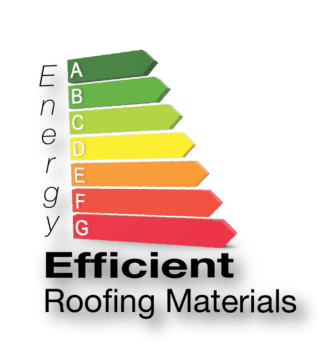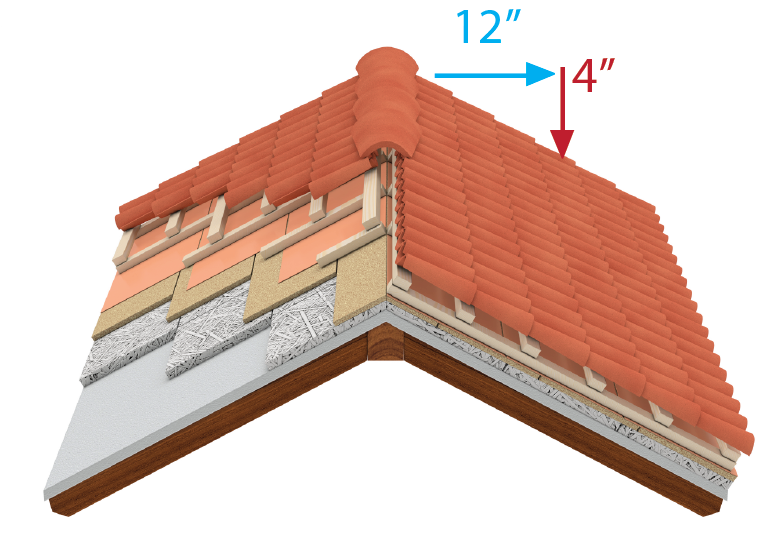
What Roofing Material is Energy Efficient?
When our customers get their roofs replaced one of the most common questions we get is “what roofing material is energy efficient?”. There is no black and white answer to this question for a few different reasons that we will discuss here. After reading this article you will have a comprehensive understanding of which materials are energy efficient.
What does Energy Efficiency mean for a Roofing Material?
First, let’s talk about what makes material energy efficient. There are two basic concepts that dictate a material’s energy efficiency as it relates to roofing materials, reflectivity, and emissivity. Let’s first look at reflectivity.
Reflectivity
Reflectivity is a fancy word that just means the ability of a material to reflect light or radiant heat. The biggest factor that determines a material’s reflectivity usually just comes down to color. We learned early on in school that while the color white reflects all other colors, black does just the opposite and absorbs all colors. So, just bear with me a moment and lets all nerd out and discuss why this concept matters.
 Remember back to science class when observing a prisms effect on light and how it separates the light into colors, the colors of the rainbow. Each color has different energy; violet being the highest energy level and red the lowest. Light energy can be converted into heat energy. When the light’s photons are absorbed by a material’s atoms causing them to become vibrationally excited heat is created. While the material’s atoms are always vibrating the absorption of the photons will increase the vibrations of the atoms. These atoms collide with other nearby atoms creating heat that resonates throughout the rest of the material ultimately heating it as a whole.
Remember back to science class when observing a prisms effect on light and how it separates the light into colors, the colors of the rainbow. Each color has different energy; violet being the highest energy level and red the lowest. Light energy can be converted into heat energy. When the light’s photons are absorbed by a material’s atoms causing them to become vibrationally excited heat is created. While the material’s atoms are always vibrating the absorption of the photons will increase the vibrations of the atoms. These atoms collide with other nearby atoms creating heat that resonates throughout the rest of the material ultimately heating it as a whole.

So, if we can block the atoms in the material from absorbing the photons from the light, we can effectively decrease the amount of heat that is created. To do this we use materials that have a lighter color so that less of the light’s photons are absorbed and more are reflected. This is also achieved with certain coatings like Kynar 500® which are designed to help block the absorption of the light, but even with these kinds of coatings, the better performing colors are always going to be the lightest colors.
Emissivity
Now, what about the light that is absorbed? How does that relate to the energy efficiency of a material? Well, this is where the emissivity of the material comes in to play. The emissivity of a material’s surface is its ability and effectiveness to release energy as thermal radiation. Basically, how long the material holds the heat. For example, cast iron pans have long been used in cooking for their ability to hold heat for a long period of time. Cast iron has a low emissivity which means it would be a poor choice to use to make an energy-efficient roofing material.
Energy-Efficient Roofing Material
Now that we understand how the heat is created and released, we can begin to look at the actual roofing materials and discuss which are energy efficient and why. We will look at options for both steep and low sloped roofs separately since they only share some of the same materials.
Steep-Sloped Roofing Material
A steep-slope roof is your typical roof on residential homes. It can have a pitch of 4/12 up to 16/12 or possibly even steeper. For a 4/12 pitch roof, this simply means that for every 12 inches on a horizontal plane the roof will drop 4 inches. 
Steep-sloped roofs can use a wide variety of roofing materials like asphalt shingles, metal, wood shake, tile, and slate. Let’s look at each material individually.
- Asphalt Shingles – Asphalt shingles are not the most energy-efficient by the nature of the product however, there are several color options that are Energy Star® rated like Owens Corning’s True Definition® Duration® shingles in Shasta White. This shingle is the most energy-efficient because of it’s color but there are other colors that are also Energy Star® rated.
- Metal Roofing – Metal roofing comes in different styles and colors, each with a different energy efficiency. Again, the lighter colors will be more energy-efficient, but metal is naturally able to release heat energy quicker (higher emissivity) than many other materials such as asphalt shingles. Additionally, metal roofing systems like standing seam roofs have a Kynar 500® coating that not only provides great looking colors but also is more reflective of the sunlight so that the heat is not absorbed.
- Wood Shake- Wood shake is naturally more energy efficient than many of the other materials. It does not transfer or absorb heat as easily. However, wood shake is not that popular of a choice because of wood rot, especially in wet or humid areas.
- Tile – Tile roofing is typically one of two materials, clay or concrete, which both absorb and hold heat. To counteract this many of the tile manufacturers put a coating on the tiles to help to reflect the light away thereby absorbing less heat.
- Slate – Slate is a natural insulator and it also reflects the sun quite well. It actually will stay cooler during the hottest of summer days.
Low-Sloped Roofing Material
 When it comes to a low-sloped roof, also called a flat roof, there are a few materials that are commonly used but also some alternatives that can make any roof more energy-efficient. Here we will discuss the most commonly used materials for a low-sloped residential roof.
When it comes to a low-sloped roof, also called a flat roof, there are a few materials that are commonly used but also some alternatives that can make any roof more energy-efficient. Here we will discuss the most commonly used materials for a low-sloped residential roof.
- Modified Bitumen – Modified bitumen or often referred to as roll roofing is an asphalt product consisting of a base layer and top layer called the cap sheet. It can be applied as a self-adhered product or may use heat to apply it to the base sheet. The top sheet can be purchased in several different colors but as we learned earlier the lighter colors will be the most energy-efficient roofing material.
- Standing Seam – Standing seam roofs can be used on low slope roofs when mechanically fastened, meaning that the seam is machine crimped and tightly sealed. Just like on a steep-sloped roof the same metal is used with the Kynar 500® coating in several Energy Star® rated colors.
- TPO- Thermoplastic polyolefin (TPO) is a single-ply roofing membrane made of rubber. TPO is almost exclusively white which allows for high reflectivity. Rubber is an insulator and does not easily absorb or allow energy to pass through. Therefore, it can be highly effective at keeping heat out.
- Roof Coatings – there are several types and brands of roof coatings on the market today that can extend a flat roof up to 10 years longer and most of these coatings are all designed with energy efficiency in mind. They typically all have both a very high reflectivity value and emissivity value.
Now to choose a roofing material for your home or project may not just come down to energy efficiency but also functionality, appearance, and curb appeal are often largely considered. You need the right roofing material that best fits your roof and the color that best fits your home. However, I hope now, armed with this knowledge, you will be able to make the best choice for your home and situation.
Baker Roofing & Construction has proudly served Texans for over 17 years. We are always here to provide you with any answers to your questions.
Back to Blog